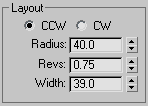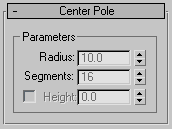The Spiral Stair object lets you specify the radius and number of revolutions, add stringers and a center pole, and more.

Types of spiral stair: open, closed, and boxed
.
Spiral stairs wind around a center
For using materials with stairs, see Stairs and Materials.
Procedures
To create spiral stairs:
- In any viewport, click for the start point of the stairs, and drag to the specify the radius you want.
- Release the mouse button, move the cursor up or down to specify the overall rise, and click to end.
- Adjust the stairs with options in the Parameters rollout.
Interface
Parameters rollout
Generate Geometry group

- Stringers
-
Creates stringers along the ends of the treads of the stairs. To modify the stringers’ depth, width, offset and spring from the floor, see Stringers rollout.
- Carriage
-
Creates an inclined, notched beam under the treads which supports the steps or adds support between the stringers of the stairs. You might also know this as a carriage piece, a horse, or a rough string. See Carriage rollout to modify the parameters.
- Center Pole
-
Creates a pole at the center of the spiral. See Center Pole rollout to modify the parameters of the pole.
- Handrail
-
Creates inside and outside handrails. See Railings rollout to modify the handrails’ height, offset, number of segments, and radius.
- Rail Path
-
Creates inside and outside paths which you can use to install railings on the stairs. See Stairs for the instructions on how to do this.
Layout group

- CCW
-
Orients the spiral stairs to be a right-hand flight of stairs.
- CW
-
Orients the spiral stairs to be a left-hand flight of stairs.

Left: CCW (counterclockwise) right-hand spiral stairs. The arrow indicates “Up.”
.Right: CW (clockwise) left-hand spiral stairs. The arrow indicates “Up.”
- Radius
-
Controls the size of the radius of the spiral.
- Revs
-
Controls the number of revolutions in the spiral.
- Width
-
Controls the width of the spiral stairs.
Steps group

- Thickness
-
Controls the thickness of the steps.

Step thickness variance between two stairs
- Depth
-
Controls the depth of the steps.

Step depth variance between two stairs
- Segs
-
Controls the number of segments 3ds Max uses to construct the steps.
- Generate Mapping Coords
-
Applies default mapping coordinates to the stairs.
Note: If a visible viewport is set to a non-wireframe or non-bounding-box display, Generate Mapping Coordinates is on for all primitives to which you apply a material containing a map with Show Map In Viewport on. If all viewports are set to wireframe or bounding box, 3ds Max turns on Generate Mapping Coordinates for primitives containing mapped materials at render time. - Real-World Map Size
-
Controls the scaling method used for texture mapped materials that are applied to the object. The scaling values are controlled by the Use Real-World Scale settings found in the applied material's Coordinates rollout. Default=off.
Center Pole rollout
These controls are available only when you turn on Center Pole on the Parameters rollout  Generate Geometry group.
Generate Geometry group.

- Radius
-
Controls the radius size of the center pole.
- Segments
-
Controls the number of segments in the center pole. Higher values display a smoother pole.
- Height
-
The spinner controls the height of the center pole. Turning on Height lets you adjust the height of the pole independently of the stairs. Turning off Height makes the spinner unavailable and locks the top of the pole to the top of the implied last riser. Typically, this riser would attach to the fascia of a landing.

Left: The center pole locked to the top of the implied last riser. (Height turned off.)
.Right: The center pole adjusted to the height you specify. (Height turned on.)